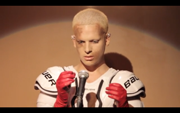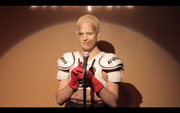
“i am your girlfriend” – a performance piece by Columbia undergrad Hari Nef – is dizzying in its ambition. The first time I watched the lip-synced, 21-minute monologue, I cried. I was sitting in my on-campus apartment; it was just past three and I was still more stoned than tired. As soon as Hari stepped into frame, I knew I was about to watch something important.
The face before me was an enigmatic one, a face that can only be tied to the present through its deliberate rejection of easy identifiers. Wearing closely-cropped bleached hair and sheered brows, Hari allows us unmediated access to their face (Hari identifies as nonbinary trans*); perfected with “natural” makeup, yet adulterated by patchily-applied dirt, their face appears neither distinctly male nor female, nor does it simply lie somewhere in between.
Video is no longer available.
The audio begins with an eerie, sci-fi-esque track that makes me feel as if I’m floating deliriously through space. Hari’s shire-green eyes, shifting out of focus, seem to find what they’re looking for as the voice of Galadriel escapes their glossed lips: “The world is changed,” they prophesize; “much that once was is lost, for now none live who remember it.” Some 30 seconds into this elfin soliloquy, the audio cuts to Scarlett Johansson, flirtatiously courting her off-screen interviewer in a Dolce and Gabbana commercial. Hari spends the next twenty minutes jumping from voice to voice: channeling the souls of Giada de Laurentis making an omelette, Margaret Cho recalling the time she shit her pants in LA traffic, and Aileen Wuornos, the convicted killer of seven men (all of whom, she claimed, she killed in self-defense). Hari, a theatre studies major, channels each woman faithfully, and through their performance we are taken on a “transfeminine odyssey” that is at once funny and severe, sexy and tragic.[1]
In a post-Internet age of unprecedented cultural consumption (to which Hari is no stranger), our understanding of identity is informed by the images and audio snippets of girls wearing bikinis on Instagram, by the men and women we scroll through on porn-Tumblrs, and by the icons we worship through fan blogs or stalk on Facebook. Our sense of self-identity is formed through this consumption, and we are resultantly an ever-evolving collage of representations. This is nowhere more evident than social media sites like Tumblr, in which users create distinct identities through compiling and commenting on (predominantly) pre-existing content; the overall aesthetic of each Tumblr becomes synonymous with its curator-user. In this way, self-representation online is an overt manifestation of Judith Butler’s theory of performativity (the citational practices which reproduce and/or subvert existing discourses, through which, subjects develop identity). While distinct aesthetics are formed on Tumblr through the reiteration of content-norms, it cannot be forgotten that these decisions are still informed by the “social, bodily, and cultural experiences of users”; that being said, the perceived technological disembodiment found in virtual space still allows users to experiment with alternative citational practices that then reconstitute and reinforce the physical body.[4] Online spaces such as Tumblr, as well as any other performance space, are therefore liminal zones in which individuals can experiment with transgressive identity-expressions in order to inform their identities in real life.
In a rather un-transgressive piece posted on Tumblr, Hari explores the notion of the “cultural participant” as “a new kind of celebrity.” Presented as a transcript of texts between blogger Brandon Marks and themself, Amber Mugabe is the textual-construction of the theoretical “It Girl to end all It Girls.”[5] Although she’s a 5’8,” twenty-six-year-old, pregnant unsigned model in her first season, is married to a Jamaican man, produces a deep house album and has an Instagram filled will images of drone strikes and family photos, the artistry of Hari and Brandon’s piece is the plausibility of Amber Mugabe’s ready canonization into the fashion hall of fame. The work is undeniably a chance for the two bloggers to flex their extensive cultural knowhow; and yet, the fact remains that their creation is merely a reiteration of obscure (if not progressive) norms within high fashion, a checklist that Hari recognizes as “obedient rather than parodic.”[6] As a finalist for DIScrit 89plus, Hari proposed performing Amber Mugabe at a benefit, hosted by the Serpentine Gallery. It is interesting to consider the ways in which Amber Mugabe would change if realized in an actual body. For one, Amber Mugabe is imperatively female, an alternative evocation of the eternal feminine that would inevitably come at odds with her performer’s body. I don’t mean to say we can’t overlook this discrepancy – it is the 21st century after all – but I think Hari’s choice of expressly female characters is intentional, or at least emblematic of our limited gender-lexicon.
In Critically Queer, Judith Butler partakes in a Freudian analysis of drag – which I will attempt to differentiate from Hari’s performances momentarily – in which she asserts that “drag allegorizes some set of melancholic incorporative fantasies that stabilize gender.”[7] This follows the assumption that gender is not an inherent trait of the subject (or that there is even such thing as an inherent subject at all), but that a subject’s identity and gender are retroactively produced through the compulsory repetition of historicized and subjectivating norms. Butler believes that drag – through its participants’ performance of the opposite gender – is a form of Freudian melancholia: an unexpressed grief over the participants’ social inability to love the same gender, which the participants actively ameliorate through the performance of heterosexualized gender-swapping (recognizing that this analysis is a generalization that cannot be essentialized).[8] The critical promise of drag, Butler asserts, has nothing to do with the proliferation of genders in this way, but “rather the exposure of the failure of heterosexual regimes ever fully to legislate or contain their own ideals …. As an allegory that works through the hyperbolic, drag brings into relief what is, after all, determined only in relation to the hyperbolic: the understated, taken-for-granted quality of heterosexual performativity.”[9]
The beauty of Hari’s performance, which certainly remains as a derivative of drag, is the tension between a nonbinary trans* individual and the gendered-lexicon in which they are able to define themself. As a talented performer, Hari convincingly conveys the reality of each woman in “i am your girlfriend.” I believe that Hari is able to empathize with the worldview of his female predecessors; the humor and pain found in Tina Tracy’s YouTube video, the beauty of Bjork’s recitation, the indignation of Aileen Wuornos or the reassurance in anime character Faye Valentine’s video-letter to her future self; all of these characters are important fragments of Hari’s identity. But included in these performances is Hari’s inability to inhabit these expressly feminine bodies, and even more frustratingly, the complete lack of a better alternative. The piece – not through hyperbole, but more subtly – problematizes the absence of a gender-queer history from which to pull, while simultaneously beginning its creation.
CITATIONS
[1] “Hari Nef.” DIScrit 89plus. DIScrit 89plus, n.d. Web. 2 Nov 2013. <http://dismagazine.com/discrit89plus/users/profile/1189>.
[2] Nef, Hari. “This Body is a Raincheck.” Original Plumbing. N.p., 31 Jul 2013. Web. 2 Nov. 2013. <http://www.originalplumbing.com/index.php/society-culture/surviving/item/545-this-body-is-a-raincheck>.
[3] Ibid.
[4] Madge, Clare, and Henrietta O’Connor. “Mothers in the Making? Exploring Liminality in Cyber/Space.”Transactions of the Institute of British Geographers . 30.1 (2005): 85. Web. 2 Nov. 2013. <http://www.jstor.org/stable/3804531>.
[5] “Hari Nef.” DIScrit 89plus. DIScrit 89plus, n.d. Web. 2 Nov 2013. <http://dismagazine.com/discrit89plus/users/profile/1189>.
[6] Ibid.
[7] Butler, Judith. “Critically Queer.” GLQ: A Journal of Lesbian and Gay Studies. 1.1 (1993): 25. Web. 2 Nov. 2013. <http://www9.georgetown.edu/faculty/irvinem/theory/JudithButler-CriticallyQueer-1993.pdf>.
[8] Ibid.
[9] Ibid, 27.






